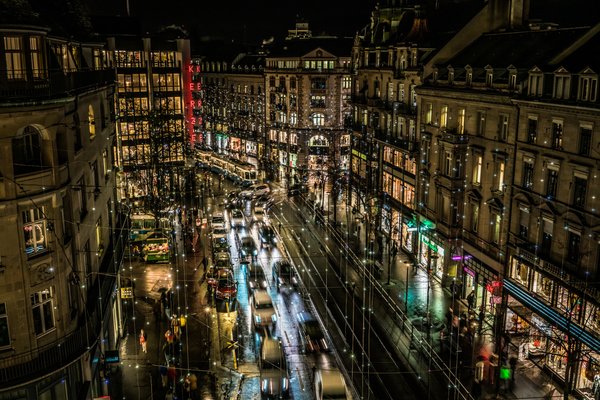
Shopping on Bahnhofstrasse
This shopping street in central Zurich runs from the main train station to Lake Zurich, with luxury boutiques, Swiss banks, and Europe's largest church clock face.
This historic district in Zurich has cobblestone streets, medieval churches, and Roman roots. Visitors can explore museums, dine in cafes, and enjoy views from Lindenhof hill.
Altstadt, Zurich's Old Town, spans both sides of the Limmat River. Its narrow cobblestone streets contain medieval guild houses and churches like the Grossmünster with its twin towers and the Fraumünster with its Chagall stained-glass windows. In this district, you can walk through centuries-old streets, visit the Swiss National Museum, shop at high-end stores on Bahnhofstrasse, or enjoy a drink at one of the many bars in Niederdorf.
The Grossmünster, a Romanesque-style church with twin towers, is a prominent feature of Altstadt. According to local lore, Charlemagne established it on the burial site of Zurich's patron saints. On the opposite bank of the Limmat, you'll see the Fraumünster, which houses Marc Chagall's colorful stained-glass windows. St. Peter's Church, another important landmark, has a clock face measuring 8.7 meters in diameter, the largest in Europe.
Niederdorf, affectionately called "Dörfli" by Zurich residents, forms the core of Altstadt. This pedestrian zone contains numerous shops, cafes, and restaurants. During the day, people come here to shop, while evenings bring a lively atmosphere with many entertainment options. Limmatquai, which runs parallel to the river, has many 17th-century guild houses that now contain restaurants and small shops. Paradeplatz, at the intersection of Bahnhofstrasse and Poststrasse, is a hub for Zurich's financial district.
Altstadt contains several important museums. The Swiss National Museum, housed in a building resembling a fairytale castle, presents exhibits on Swiss history and culture. The Kunsthaus Zürich holds one of Switzerland's largest art collections, featuring works from the Middle Ages to contemporary pieces. The Rietberg Museum offers a different perspective, focusing on art and artifacts from non-European cultures.
Bahnhofstrasse, which begins in Altstadt, is one of the most expensive shopping streets in the world. You'll find luxury boutiques and large department stores here. For a more local shopping experience, explore the small independent shops in Niederdorf. Altstadt's dining scene includes restaurants serving traditional Swiss cuisine in centuries-old buildings, as well as modern cafes and international eateries.
As evening falls, Altstadt's streets fill with people heading to its many bars, pubs, and clubs. The area around Niederdorf becomes particularly busy, with venues catering to various tastes and preferences. You can choose from quiet wine bars, lively pubs, or dance clubs, all within walking distance of each other.
Walking is the best method to experience Altstadt. You can join guided tours to learn about the district's history and discover its hidden corners. For a different view of Altstadt, take a boat trip on the Limmat. These cruises pass many of Altstadt's key sights and continue to Lake Zurich. If you plan to visit multiple sites, consider purchasing a Zürich Card, which provides discounts on tours and museum entries.
Altstadt's history stretches back over two millennia. The Romans first settled this area, establishing a customs post. Throughout the Middle Ages, Zurich grew in importance, with Altstadt at its center. In the 16th century, the district played a crucial role in the Swiss Reformation, led by Huldrych Zwingli from the Grossmünster.
Tell us about it! Is it place worth visiting, are you coming back?